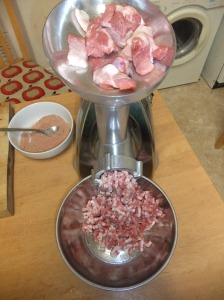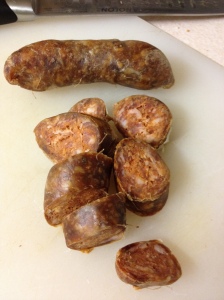Proper chorizo is one of my very favourite things in life. Cured and served cold or hot and freshly cooked, its robust paprika flavour and heavenly brick red fat are truly one of the best things you can eat. In fact, I can’t believe it’s taken me so long to have a go at making my own. I think part of the problem is that chorizo has become ubiquitous. You can get a decent Spanish cured chorizo in a lot of corner shops round my way, particularly at Borough Market or the Portuguese deli in Vauxhall
What are less easy to find are the semi-cured cooking chorizo that impart such a delicious flavour to soups, stews and rice dishes. True, you can get them at Brindisa but they’re very easy and great fun to make at home and are considerably cheaper than bought ones.
Making this recipe also gave me a good excuse for me to show off my shiny new electric mincer. After many months of hand cranking my meat (I try to avoid bad sausage puns but sometimes I just can’t help myself) I was very kindly bought a basic electric mincer as a Christmas gift. The mincer works very well, although I’m still finding my way around it and am yet to master the art of using it for sausage stuffing. On the whole though, the new machine is super quick at mincing and best of all, it’s whisper quiet.*. Great value for saving time and effort.
The recipe follows. It make a very fine sausage but its one that I will inevitably come back to and tweak, fiddle and play with in my quest for a perfect chorizo. I’ll post any updates I do as and when in this post.
Jon’s Semi-Cured Chorizo
800g pork shoulder
150g pork belly
75g breadcrumbs
22g salt
2g Prague powder #1
10g smoked paprika
10g sweet paprika
7g garlic powder
2g oregano
1g ground chipotle
50ml white wine
Hog casings, about 6 feet
First soak your casings in clean cold water for a couple of hours to remove the salt in which they’re packed.
Cube the pork shoulder and belly into chunks small enough to feed through your mincer. Place in the freezer to chill for 30 minutes or so. In the meantime, weigh out all of your spices and mix thoroughly. When you’re ready to mince your pork, assemble your mincer and fit it with a coarse mincing plate. Remove your meat from the freezer and slowly feed it through the mincer until you have a big pile of minced meat in front of you. Transfer it to a large mixing bowl.
Using your hands or a spoon, slowly fold in your spices and breadcrumbs, adding enough white wine to bind. Make sure everything is thoroughly combined.This is especially important when you’re using Prague powder as you don’t want to end up with all of your sodium nitrite in one place. There’s a lot of discussion on the internet about whether cured food is bad for you but suffice to say, a big build up of sodium nitrite in one go will do you no good at all.
At this stage, you can decide whether to stuff your chorizo into skins. Loose, the meat is great with scrambled eggs or thrown into a tomato sauce to give it a smoky depth of flavour. If you decide not to stuff the mixture pack it firmly into a tupperware box with a lid. Cover and refrigerate for about a week, draining off any liquid that leaks out every couple of days.
Otherwise, remove your casings from their soaking water and rinse thoroughly inside and out to remove any excess salt. Slide the skins over your stuffing tube and proceed to stuff your sausages in the usual way. I have to confess that I haven’t quite got the hang of my new elecric mincer/stuffer so my sausage filling wasn’t as even as I’d like. However, practice makes perfect and I daresay, I’ll have properly stuffed bangers before too long…
When you have fed all of your sausagemeat through your mincer, remove the unlinked sausage from your stuffing tube and tie off. Link your sausages in the usual way and place in a rack in the fridge to dry for 7-10 days. By this time the chorizos will have darkened, lost some of their weight and will feel firmer to the touch. They’ll still need cooking before you eat them. They are brilliant fried gently then cooked with rice and peppers or just in a crusty roll with some peppery salad and aioli.
Next time I make this, I’ll definitely up the chilli quota but then they’ll be a different sausages. These are pretty mild sausages compared to a lot of other chorizos but that does allow the flavour of the paprika and oregano (always use good quality oregano otherwise you won’t taste it at all) to shine through beautifully.
*It seems the evil empire have blocked that video. For those that don’t know its a fine Simpsons infomercial for the Juice Loostener.












